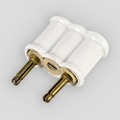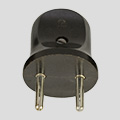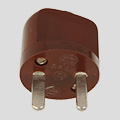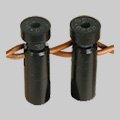 |
Classic plugs and sockets made in continental Europe, overview |
 |
Classic plugs and sockets made in continental Europe, overview |
|
Classic, continental
European plugs and
sockets are shown on seven pages. Details are given below. > Click on the accompanying image to open a page < Details and logos of German manufacturers are given on a separate page. At the bottom of the page you will find general information about plugs and materials used. Many items have been donated by Reiner Hahn {RH} and Wieger Nieuwenhout {WN}. |
 Part 1 |
Not earthed plugs
and sockets Plugs have 4 mm pins and a 19 mm pin spacing. Sockets are designed for these not earthed plugs. Because of the large number of examples, plugs and sockets are split into two parts: 1: flat plugs (i.e. have a rectangular base), and 2: plugs that have a round base. Most material has been made in Germany*. |
 Part 2 |
 |
Multi-plugs and
adapters Not earthed plugs with 1 to 4 outlets. Multiple outlet extension cords. Lampholders with outlet. |
 |
Uncommon earthed and
non-earthed plugs and sockets A variety of obsolete plugs and sockets with 2 or 3 pins that were designed for special applications, including plugs for more than 10 Amp. Classic plugs with earth clips (Schuko type) are shown separately. |
 |
Plugs with unusual
types of pins Two types are shown: left: plug with pins curved at a 90º angle; right: plug with concentric pins. |
 |
 |
Connectors to branch
off cords A German (Daki) and French (T.E.G.) type of connector have been designed to branch off flexible cords that are not protected in conduits. |
| * More classic material from France
and Switzerland is shown on the
corresponding standard pages. |
| About
the choice for plugs with a 19 mm pin spacing It is remarkable that from the early days of home electrification, continental European countries have used 19 mm pin spacing for common domestic plugs. 19 mm equals ¾ inch. For industrial purposes the inch has been used in many European countries for a long period of time. It could be that two aspects were in favour of a 19 mm pin spacing. First, it is a convenient size to construct a safe plug that is handy for domestic use. Second, choosing - initially on a voluntary basis - for a single design of pins opens a large market, which is to the benefit of manufacturers and buyers. Therefore it might be that around 1900 plugs with 4 mm pins, 19 mm apart became the common continental European household plug by the will of installation manufacturers. German DIN VDE 9400-9403, published in 1924, declared 19 mm pin spacing as the official standard for not earthed 6 and 10A - 250V plugs and sockets. Details are shown on a separate page. |
| Materials used for classic plugs and
sockets Timber First material to be used for plugs. Only hard and relative durable wood is appropriate. For example Boxwood and Lignum vitae (Pockholz). Processing timber is relative easy, but its moderate durableness and hygroscopic characteristics are disadvantages. In Germany, timber was already replaced by porcelain and ebonite around 1905, but in some other countries timber plugs were still offered in the 1930s. Porcelain A white ceramic. It is an excellent insulator against heat and electrical tension that can be shaped in each desirable form. Porcelain has been used for plugs or critical parts of plugs for about a century. Steatite (soapstone) A technical ceramic. Like porcelain, grinded soapstone can be molded in forms and glazed in any colour. Dielectric and thermal properties are comparable to porcelain, but processing is easier and cheaper. From the 1920s steatite was much more often used for plugs than porcelain. The body colour of steatite is light beige, while porcelain is white. |
Ebonite Hard, black vulcanized natural rubber. A relative high sulfer content and prolonged times of vulcanizing results in a solid product. Around 1900 it became the first choice material for - at that time - small series of plugs. They were hand made out of rods or plates of ebonite. In the 1920s ebonite was superseded by Bakelite that allowed production of large quantities of complex shapes. Bakelite Bakelite was developed by Leo Baekeland in 1907 and patented in 1909. It is a phenol formaldehyde resin that can molded to produce large quantities of identical units. Although customized molds and molding presses were expensive, Bakelite became the preferred material for plugs as sales of electrical appliances increased dramatically from the early 1920s. Bakelite is an excellent insulator and is resistant to heat, but it may swell under prolonged humid conditions. Phenolic resins have to be reinforced with a filling agent. Sawdust was most commonly used in plugs. From the 1960s Bakelite was gradually replaced by other thermosetting polymers. |
| Note on dating of plugs | Most plugs shown on the following pages
had been made for many years or decades. Given dates refer either to year or decade in which production started, or the full period of production. Dates are based on: (i) old catalogs of manufacturers or shops that sold or imported electro-technical devices, or (ii) estimates based on technical and formal appearances of a plug |
| |
D i g i t a l M u s e u m o f | |
P l u g s a n d S o c k e t s | |